Reliable shipping is the foundation of customer trust in today’s fast-moving business world. When shipments arrive late, damaged, or at the wrong destination, customers lose confidence and competitors gain the upper hand. Unfortunately, many companies fall victim to logistics errors that could have been prevented with the right planning and systems.
When logistics systems break down, even small errors can compromise delivery schedules, create customer dissatisfaction, and increase operational costs. By understanding these risks early, businesses can take proactive steps to safeguard shipping reliability and maintain customer trust.
In this article, we’ll highlight the top three logistics errors that put reliable shipping at risk, explore why they happen, and share actionable ways to prevent them. By understanding these common pitfalls, businesses can reduce supply chain risks and avoid common shipping problems that hurt their reputation.
Why Fixing Logistics Errors Matters
Fixing these logistics errors isn’t just about avoiding mistakes it’s about building long-term trust and operational efficiency. Companies that prioritize accuracy and transparency see benefits such as:
- Fewer customer complaints and returns.
- Stronger relationships with shipping partners.
- Reduced costs from errors and re-shipments.
- Improved ability to scale as demand grows.
Ultimately, avoiding common shipping problems gives businesses the edge they need to compete and perform strongly
Why Do Logistics Errors Happen?
- Manual processes that leave room for human mistakes.
- Poor communication between teams (sales, warehouse, carriers).
- Using outdated systems with little visibility.
- Relying too heavily on one shipping provider.
In this blog, we’ll explore the top three mistakes companies make, why they happen, and how to prevent them. Avoiding these pitfalls helps reduce supply chain risks, eliminate common shipping problems, and build stronger customer trust.
Mistake 1: Poor Inventory Management
One of the most frequent logistics errors is failing to track inventory accurately. When businesses don’t know what’s in stock—or worse, sell items they don’t actually have—it creates shipping delays and frustrated customers.
Why this happens:
- Lack of real-time tracking systems
- Manual stock counts that are prone to human error
- Poor communication between sales and warehouse teams
The consequences:
- Late deliveries due to backorders
- Increased storage costs from overstocking
- Customer dissatisfaction when items go out of stock unexpectedly
How to fix it:
Invest in inventory management software that integrates with your order system. Automating stock updates minimizes logistics errors and ensures you can fulfill orders accurately. Regular audits also help spot problems before they affect customers.
Mistake 2: Inefficient Transportation Planning
Another major source of logistics errors is poor planning in transportation and delivery. Without clear strategies, companies often face high shipping costs, late deliveries, or damaged goods.
Why this happens:
- Choosing unreliable carriers
- Failing to optimize delivery routes
- Ignoring backup plans for weather or traffic disruptions
The consequences:
- Increased fuel and labor costs
- Missed delivery windows
- Reduced trust and repeat business
How to fix it:
Use route optimization tools and partner with carriers known for reliability. Diversify shipping options so you’re not dependent on a single provider. By tackling these transportation issues, you reduce supply chain risks and avoid common shipping problems like missed deadlines.
Mistake 3: Lack of Communication and Visibility
A hidden but serious cause of logistics errors is poor communication across teams and with customers. When businesses don’t share updates in real time, mistakes go unnoticed until they become major problems.
Why this happens:
- Using Siloed systems that don’t talk to each other
- Not updating customers about order status
- Limited visibility into shipping stages
The consequences:
- Misrouted or lost packages
- Increased customer complaints
- Lack of accountability within teams
How to fix it:
Adopt centralized tracking systems that allow teams to view order status at every stage. Share real-time shipping updates with customers to build trust. Better visibility reduces logistics errors and helps resolve common shipping problems before they escalate.
Conclusion
Reliable shipping depends on avoiding costly logistics errors. From poor forecasting to inefficient transportation and weak communication, these mistakes create unnecessary supply chain risks and common shipping problems. By addressing them proactively with technology, training, and strong systems, businesses can ensure smoother operations and deliver the reliability customers expect.
Consistency builds trust and in logistics, trust is everything.





